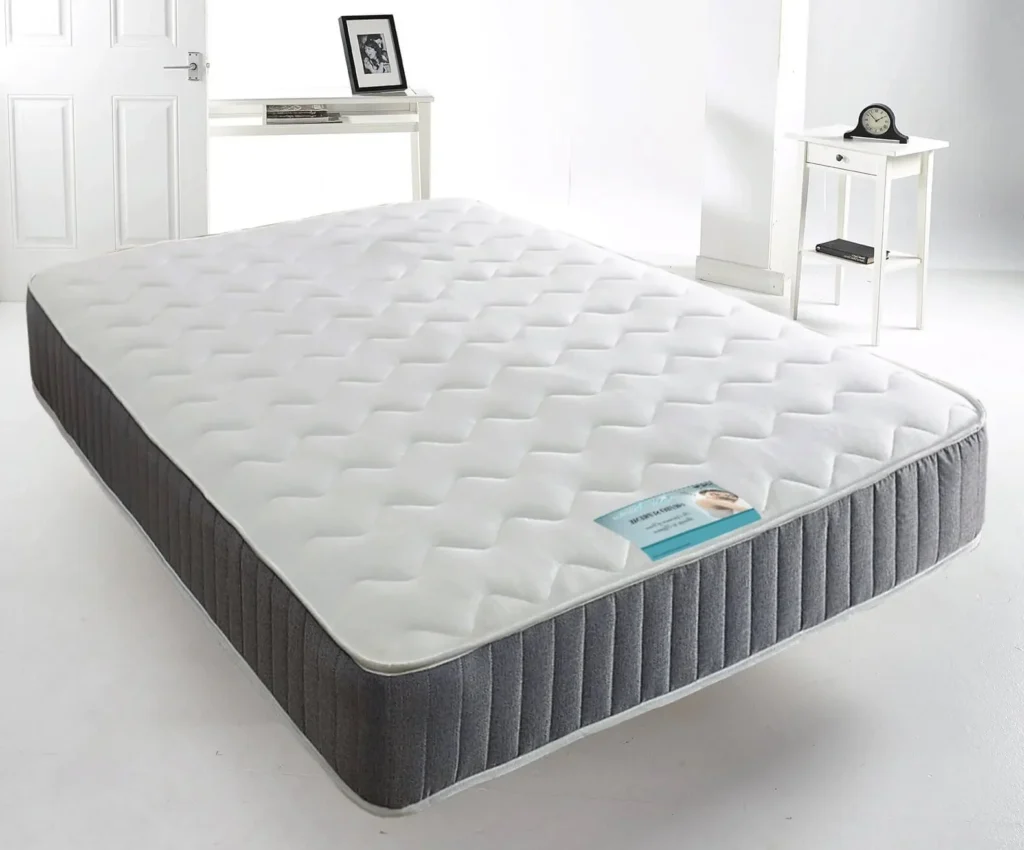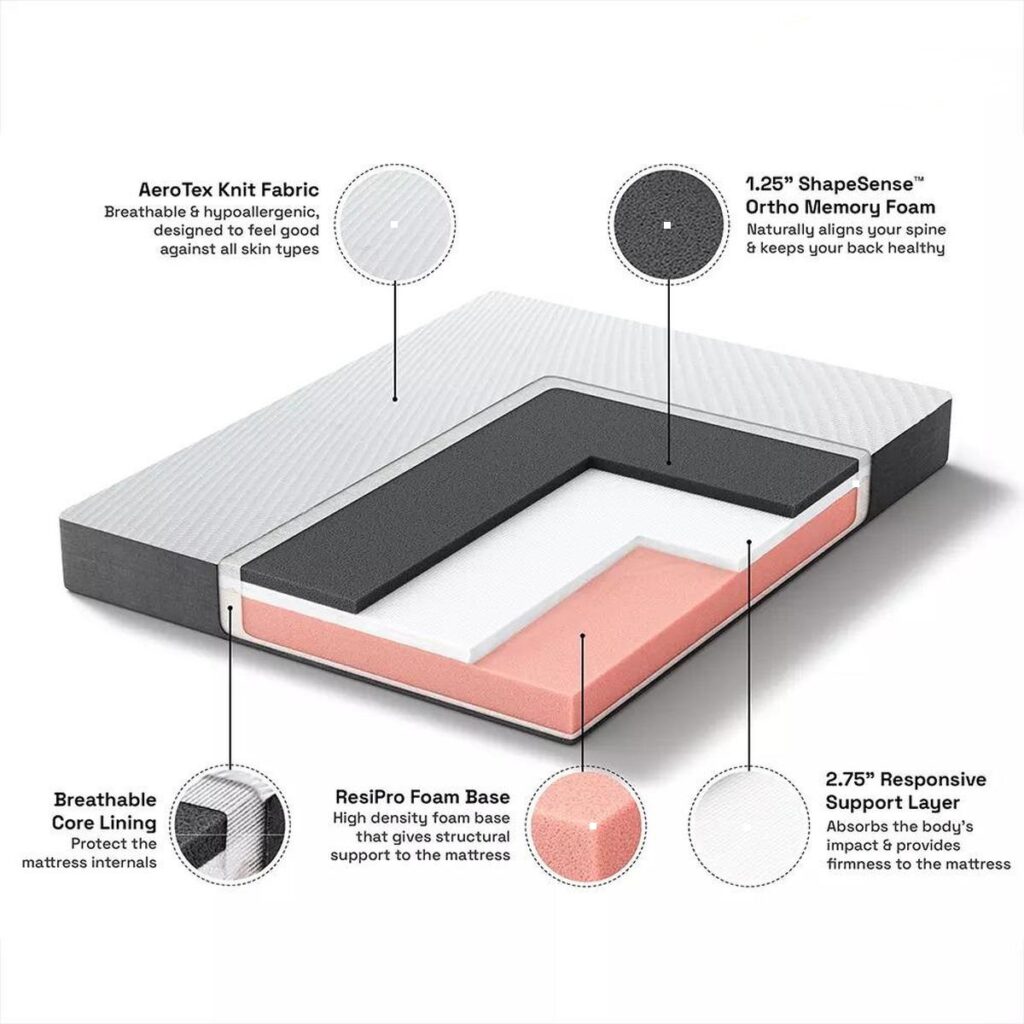No products in the basket.
Uncategorized
Benefits of buying Memory Foam Orthopedics Spring Mattress
Table of contents
Memory foam orthopedic spring mattresses have gained popularity in recent years due to their numerous benefits for sleep quality and overall well-being. These Memory Foam Orthopedics Spring Mattress mattresses combine the support of traditional spring coils with the comfort and contouring properties of memory foam, offering a unique sleeping experience with memory Foam orthopedic Spring mattresses.
Memory Foam Orthopedics Spring Mattress: History
The Memory Foam Orthopaedics Spring Mattress has a fascinating history that traces back to the 1960s. when NASA developed memory foam for aircraft seats to enhance cushioning and safety. This innovative material gradually transitioned to the healthcare sector, gaining popularity for its pressure-relieving properties and support for orthopedic needs.
In the 1990s, memory foam entered the consumer market, revolutionizing the mattress industry with its ability to contour to the body and alleviate discomfort. Today, Memory Foam Orthopaedics Spring Mattresses combine the benefits of memory foam and traditional spring coils, offering a comfortable and supportive sleep surface for optimal rest and spinal alignment.
Memory Foam Orthopaedics Spring Mattress Benefits

Comfort and Support
Memory foam adjusts to the body’s contours, relieving pressure points and reducing discomfort, especially for those with joint or back pain. The mattress promotes proper spinal alignment, reducing strain on the back and improving sleep posture. The foam absorbs motion, minimizing disturbances from a partner’s movements during sleep.
Durability and Longevity
High-quality materials ensure durability, resisting sagging and maintaining support over time. Memory foam is resilient to wear and tear, providing long-lasting comfort and support. The dense structure of memory foam inhibits the growth of allergens like dust mites, making it ideal for allergy sufferers.
Temperature Regulation

Many memory foam mattresses are designed with cooling properties, wicking away heat for a cooler sleep surface. The foam’s open-cell structure allows heat to dissipate, preventing overheating during sleep.
Customization Options
Memory foam mattresses offer various firmness levels to suit individual preferences and sleeping styles. They are available in different sizes, from twin to king, providing options for different bed frames and room sizes.
Cost-Effectiveness
Despite initial investment, memory foam mattresses offer long-term value with their durability and comfort. Improved sleep quality can lead to reduced healthcare costs and increased productivity, saving money in the long run.
Maintenance and Care Tips
Regular cleaning and maintenance prolong the mattress’s lifespan, ensuring continued comfort and support. Rotating and flipping the mattress evenly distributes wear and maintains its shape over time.
| Maintenance Tips | Details |
| Regular Cleaning | Use a vacuum cleaner with an upholstery attachment to remove dust, debris, and allergens regularly. |
| Spot clean stains with mild detergent and water. | |
| Avoid Liquids | Protect the mattress from spills and liquids by using a waterproof mattress protector. |
| Air Out the Mattress | Open windows or use a fan to allow the mattress to breathe and prevent moisture buildup. |
| Rotate Every 3 Months | Rotate the mattress 180 degrees every three months to promote even wear and maintain its shape. |
| Flip Annually (if dual-sided) | If your mattress is dual-sided, flip it over once a year to prevent sagging and extend its lifespan. |
| Use a Mattress Cover | Invest in a high-quality mattress cover to protect against spills, stains, dust mites, and allergens. |
| Inspect Regularly | Check the mattress regularly for signs of wear, tears, or damage, and address any issues promptly. |
Warranty and Customer Support
Understanding warranty coverage ensures peace of mind regarding repairs or replacements. Accessible customer support makes addressing any concerns or issues with the mattress easier.
Environmental Impact

Many memory foam mattresses use eco-friendly materials, reducing their environmental footprint. Some manufacturers offer recycling programs for old mattresses, contributing to sustainability efforts.
Tips for Buying Memory Foam Mattresses
- Determine Your Preferences: Evaluate your desired firmness level, mattress thickness, and any specific features like cooling properties to ensure a comfortable and customized sleeping experience.
- Research Brands and Models: Read reviews and compare ratings of different mattress brands and models to identify reputable manufacturers and find a suitable mattress that meets your requirements.
- Test the Mattress: Visit showrooms or take advantage of trial periods offered by manufacturers to physically test the mattress, checking for comfort, support, and overall satisfaction before making a purchase decision.
- Check Warranty and Return Policies: Understand the warranty coverage, including terms and duration, as well as the return policies in case the mattress doesn’t meet your expectations or requires replacement or repair.
- Consider Budget and Value: Balance your budget with the quality and features offered by the mattress to ensure you get the best value for your investment, focusing on long-term comfort and durability.
- Assess Materials and Construction: Examine the materials used in the mattress, such as memory foam layers, spring coils, and orthopedic support features, to ensure they align with your comfort and support needs.
- Review Customer Feedback: Look for customer testimonials and feedback to gain insights into real-world experiences with the mattress, including durability, comfort levels, and overall satisfaction, helping you make a more informed decision.
Conclusion
Investing in a memory foam orthopedic spring mattress offers a range of benefits, from improved sleep quality and comfort to durability and environmental sustainability. Consider the unique features and customization options available to find the perfect mattress.
Benefits of buying Memory Foam Orthopaedics Spring Mattress
FAQS
What is the difference between memory foam mattresses and traditional spring mattresses?
Memory foam mattresses use viscoelastic foam that conforms to your body’s shape, offering personalized support and pressure relief. Traditional spring mattresses have coil springs that provide bounce and support but may not contour as closely to your body.
Are memory foam orthopedic spring mattresses suitable for people with back pain?
Yes, memory foam orthopedic spring mattresses are often recommended for individuals with back pain. Combining memory foam’s contouring properties and spring coils’ support can help alleviate pressure on the spine and promote better alignment.
Do memory foam orthopedic spring mattresses sleep hot?
Many modern memory foam mattresses are designed with cooling technologies to prevent overheating. Look for features like open-cell foam and gel-infused layers that promote airflow and regulate temperature for a cooler sleep surface.
How long do memory foam orthopedic spring mattresses typically last?
The lifespan of a memory foam orthopedic spring mattress can vary depending on factors like quality, usage, and maintenance. On average, a well-maintained mattress can last between 7 to 10 years or more, providing consistent comfort and support over time.

